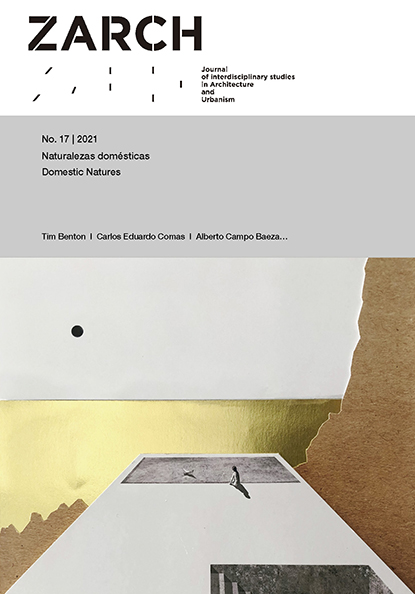La estética de lo doméstico. Olmsted y la relación entre casa y paisaje en los Estados Unidos del XIX
DOI:
https://doi.org/10.26754/ojs_zarch/zarch.2021176071Palabras clave:
Paisajismo estadounidense, Frederick Law Olmsted, Suburbio norteamericano, Central Park, Domesticidad en el siglo XIXResumen
Durante las primeras décadas del siglo XIX, en los Estados Unidos la casa sirvió como elemento de mediación tanto física como intelectual con un entorno por definir en un país por definir. Por iniciativa individual, cientos de familias se fueron mudando a las periferias urbanas para construir allí su hogar y dar lugar a un modo de vida particular para la clase media. Poco tardaron entonces en aparecer promociones de viviendas unifamiliares en los aledaños de importantes ciudades. Una forma de asentamiento periférico que se modernizó, según varios autores, cuando Frederick Law Olmsted planeó y construyó el barrió de Riverside, a las afueras de Chicago. Muy alabado por haber sabido combinar un loteado sistemático con una estética paisajista, el proyecto incorporaba además obra pública propia de los centros urbanos.
El artículo argumenta que la aportación de Olmsted a esta relación entre casa y paisaje no fue únicamente práctica. Contaba también con una faceta retórica orientada, sobre todo, a la domesticación de los Estados Unidos. Para ello, se propone una relectura de dos de sus primeros proyectos: el Central Park de Nueva York y el nunca construido College de Berkeley. A partir de sus informes se aprecia hasta qué punto la idea del hogar motivaba su discurso paisajístico. A su vez, esto permite mostrar que una de las posturas más avanzadas de Olmsted fue el desarrollo de una categoría estética derivada de la vivienda: la estética de lo doméstico, un entendimiento del paisaje como una entidad que emergía de la casa.
Descargas
Citas
Archer, John. 1983. Country and City in the American Romantic Suburb. Journal of the Society of Architectural Historians 42 (2): 139-156.
_____. 2005. Architecture and Suburbia: From English Villa to American Dream House, 1690-2000. Minneapolis: University of Minnesota Press.
Cott, Nancy F. 1997. The Bonds of Womanhood. New Haven: Yale University Press.
D’Amore, Maura. 2014. Suburban Plots: Men at Home in Nineteenth-century American Print Culture. Amherst and Boston: University of Massachusetts Press.
Downing, Andrew Jackson. 1841. A Treatise on the Theory and Practice of Landscape Gardening, Adapted to North America. Nueva York-Londres: Wiley and Putnam.
Hayden, Dolores. 2003. Building Suburbia: Green Fields and Urban Growth, 1820-2000. Nueva York: Pantheon Books.
_____. 1984. Redesigning the American Dream: The future of Housing, Work and Family Life. Nueva York-Londres: W.W. Norton & Co.
Kolodny, Annette. 1984. The land before her: fantasy and experience of the American frontiers, 1630-1860. Chapel Hill: University of North Carolina Press.
Kowsky, Francis R. 1987. Municipal Parks and City Planning: Frederick Law Olmsted's Buffalo Park and Parkway System. Journal of the Society of Architectural Historians 46 (1): 49-64.
Machor, James L. 1994. Pastoral Cities: Urban Ideals and the Symbolic Landscape of America. Madison: The University of Wisconsin Press.
Mariné, Nicolás. 2020. Del Fresh Pond al Mystic River: topografía y horizonte en el paisajismo de los Olmsted. Proyecto. Progreso. Arquitectura 23: 160-78.
McLaughlin, Charles Capen, ed. 1983. The Papers of Frederick Law Olmsted Vol. I: The formative Years, 1822-1852. Baltimore: The Johns Hopkins University Press.
Olmsted, Frederick Law. 1871. Suburban home grounds. The Nation, octubre.
_____. 1888. Plan for a small Homestead. Garden and Forest 1 (mayo): 111-13.
_____. 1970 [1870]. Public Parks and the enlargement of towns. Nueva York: Arno Press-The New York Times.
_____. 2015. Carta a Marianna Mariana Griswold Van Rensselaer; 18 de junio, 1893. En Frederick Law Olmsted: Writings on Landscape, Culture, and Society, ed. Charles Beveridge. Nueva York: Library of América.
_____. s/f. Scenery, Society and Gardening. Biblioteca del Congreso de E.E.U.U; Frederick Law Olmsted Papers; Speeches and Writings File, 1839-1903.
Olmsted, Frederick Law y Vaux, Calvert. 1866. Report upon a projected improvement of the estate of the College of California, at Berkeley, near Oakland. San Francisco: Towne and Bacon.
_____. 1868 [1858]. Description of a plan for the improvement of the Central Park, ‘Greensward’. Nueva York: The Aldine Press-Sutton, Bowne & Co.
_____. 1868. Preliminary report upon the proposed suburban village at Riverside, near Chicago. Nueva York: Sutton, Browne & Co.
_____. 1871. Chicago South Park Commission Report; Accompanying Plan for Laying Out The South Park. S.l., s.e.
_____. 1928 [1872]. Report on Communication between the Terrace and the Reservoirs, April 16, 1872. En Forty Years of Landscape Architecture. Volume II: Central Park as a Work of Art and as a Great Municipal Enterprise, 1853-1895, ed. Frederick Law Olmsted Jr. y Theodora Kimball, 379-83. Nueva York-Londres: G. P. Putman’s Sons.
_____. 1928 [1874]. Proposition to place a colossal statue at the south end of the Mall. En Forty Years of Landscape Architecture. Volume II: Central Park as a Work of Art and as a Great Municipal Enterprise, 1853-1895, ed. Frederick Law Olmsted Jr. y Theodora Kimball, 494-98. Nueva York-Londres: G. P. Putman’s Sons.
Peterson, Jon A. 2003. The Birth of City Planning in the United States, 1840-1917. Baltimore-Londres: The John Hopkins University Press.
Rybczynski, Witold. 1999. A Clearing in the Distance: Frederick Law Olmsted and America in the Nineteenth Century. Nueva York: Scribner.
Schuyler, David. 2000. Riverside. The first comprehensively designed suburban community in the United States. En Iconic Planned Communities and the Challenge of Change, eds. Mary Corbin Sies, Isabelle Gournay y Robert Freestone, 40-60. Filadelfia: Penn Press.
VV.AA. 1853. Homes of American authors; comprising anecdotical, personal, and descriptive sketches. Nueva York: G. P. Putnam and Co.
Willis, Nathaniel P. c.1840. American Scenery; or Land, Lake and River Illustrations of Transatlantic Nature. First Quaterly Part. Londres: George Virtue.


